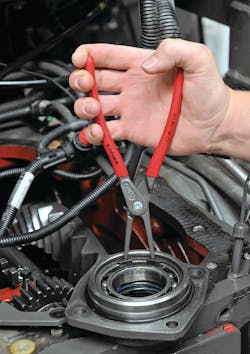At first glance, it may seem like hand tools have not changed as much or as drastically over the years as have some other shop product categories. But in fact these repair staples continue to undergo major improvements in terms of quality, performance and user comfort. With each new generation of professionals, manufacturers up the ante.
Take a set of pliers, for example. Consider how it grips. Is it comfortable to hold? Will it stay put? Subtle changes can make a big impact. Todd Shumate, president of KNIPEX Tools, says “Pliers started with bare handles and then improved when dipped Plastisol-type handles were developed. Dipped handles are still popular, but now most quality pliers are available with single or dual material comfort grip handles.” KNIPEX Tools specializes in the development and production of professional pliers.
Bill Bliss, manager of marketing communications, Apex Tool Group, LLC (GearWrench) adds handle types are often personal preference, but variations can offer nice benefits. “Polished chrome makes cleanup faster, while cushioned handles are more comfortable and may keep you from slipping.” GearWrench is a manufacturer of professional hand tools for technicians. Even a seemingly modest feature like an extended handle can be a great help to a tech, as it means he or she can get to a fastener without putting the vehicle on a lift.
Getting in the nooks
In addition to hand tools improving comfort and ergonomics, smaller-sized tools can reap big rewards. While repair professionals are always on the lookout for tools that can improve ease and comfort, they also need tools that stand up to a specific fix. Luke Tucker, sales manager with E-Z Red, a company that specializes in lighting, hand tools and battery products, points out many hand tools are specifically designed to fit into tight spaces. For example, “The head of a quarter stick needs to be thin enough, but long enough, to be able to reach under a dashboard or bumper,” says Tucker.
Likewise, GearWrench’s Bliss says ratchets with a smaller swing arc allow access to tight spaces without repositioning the tool between turns or removing components to get adequate clearance.
Quality over quantity
Whether in the market for ratchets, wrenches or pliers, across the board, techs want a quality tool that they can be confident will last them for years to come. It must be well-made and durable for tough jobs. If something goes wrong, they’d prefer knowing they’ve purchased from a company that stands behind its product. After that initial well-planned purchase many would prefer to stop shopping. Period.
Bliss at GearWrench says when it comes to hand tools, a reputation for quality is essential. “They’re subjected to tremendous force, so consistent strength is very important.”
A good warranty doesn’t hurt, either. “Warranty is a huge concern,” says KNIPEX Tools’ Shumate. “[Techs] want to know that the tools they are using are warrantied for life for defects.” He says this is typically one of their first questions when they weigh the pros and cons of a new hand tool purchase.
E-Z Red's Tucker agrees that technicians find tools that carry lifetime warranties, in addition to other characteristics, more appealing.
“The newer technicians also find the coloring of hand tools enticing,” says Tucker. “Some questions we typically are asked are, ‘Will this tool do a specific job better than another product? Is this tool field repairable? Is there a high warranty issue?’”
Know thy customer
Mobile distributors would do well to familiarize themselves with each technician on their route. “Learn whether this tech likes flex head ratchets or non-flex,” says E-Z Red’s Tucker. “Ask your customer what job they would be using the tool for, how often they’ll be using it and what type of vehicle/machinery/aircraft he or she works on. If the tech has a specialty you may be able to recommend a certain item rather than show them new products they may not be interested in.”
The right questions are essential. Bliss at GearWrench says another good approach is for distributors to ask customers what tool applications give them the most trouble, then follow up and ask what they think might help. “You may have a solution on your truck they aren’t aware of,” he says.
And of course, be knowledgeable about the products on your truck. E-Z Red’s Tucker says mobile tool dealers should recommend to customers that specialty tools for hard-to-reach areas only be used for that particular application, so the life of the tool is not compromised.
Finally, it’s always better to show than tell. “Demonstrating tools is important to close the deal,” says KNIPEX’s Shumate. “If [mobile sellers] can show how the tool works, they have a better chance of selling it.”
Another tip: “Display hot sellers at eye-level whenever possible,” says GearWrench’s Bliss. “When demonstrating a tool with a new feature, have a sample of similar “standard” products available to compare and contrast the differences and advantages.”
All agree that putting top sellers at eye-level is the best way to grab a tech’s attention. Display new items where they stand out. Use colors and packaging that catches the eye. Keep your truck clean and clutter-free, and know specifically what each customer needs. Then demo and chat. Some tool manufacturers, like KNIPEX, will provide distributors with various free demo tools--such as a grip bar--to help show off a tool’s grip strength, etc. to customers.
Using demonstrations and special promotions can really help a customer feel great about his or her hand tool purchase. Tucker at E-Z Red says it can be beneficial for a tool truck to have a TV streaming product videos and current deals.
What’s next in line?
As vehicles change and become more complex, so will the products designed to fix them. It’s hard to pinpoint which modifications are coming around the bend, but it’s clear hand tools will continue to become stronger, more comfortable and increasingly specialized.
KNIPEX Tools' Shumate says even pump pliers, which are still manufactured by some as a simple arc joint, have been improved upon dramatically. “The best jaws are now hexagon shaped, letting the user securely grip any shaped item,” says Shumate. He adds new styles of pump pliers, like the KNIPEX Cobra, can have as much as 30 percent more capacity than previous versions and an exceptionally strong grip.
Innovation is a fact of life. And in this case, it’s all in the name of better business.
“Technicians want a tool that will save them time and money when making a repair,” says Shumate. “The quicker they can get it done, the more repairs they can make in the day, the more money they make.”


